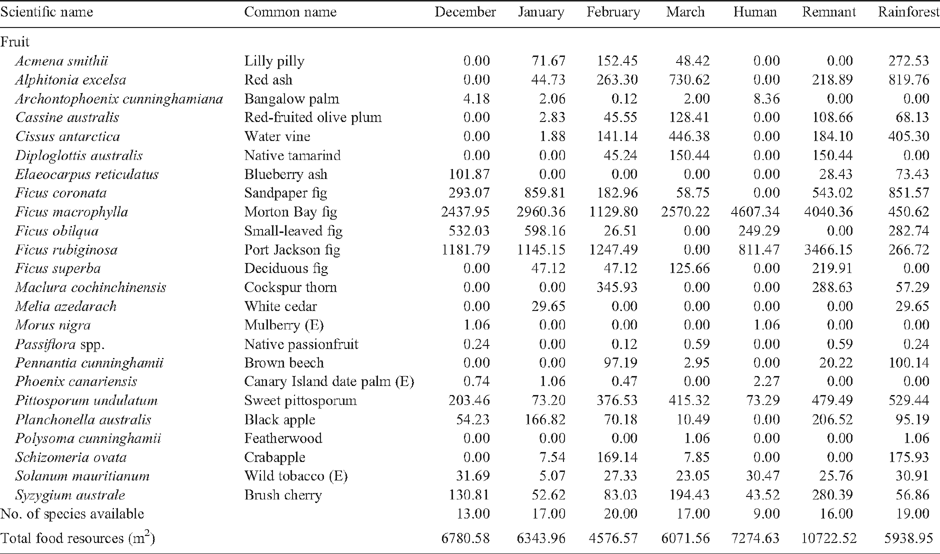Fruit availability and utilisation by grey-headed flying foxes (Pteropodidae: Pteropus poliocephalus) in a human-modified environment on the south coast of New South Wales, Australia
Emily Schmelitschek A C , Kristine French A C and Kerryn Parry-Jones BA Institute of Conservation Biology, University of Wollongong, Wollongong, NSW 2522, Australia.
B Institute of Wildlife Research, The University of Sydney, NSW 2006, Australia.
C Corresponding authors. Email: emilys@exemail.com.au, kris@uow.edu.au
Wildlife Research 36(7) 592-600 https://doi.org/10.1071/WR08169
Submitted: 2 December 2008 Accepted: 7 July 2009 Published: 28 October 2009
Abstract
Context. Extensive clearing and modification of habitat is likely to change many facets of the environment including climate and regional food resources. Such changes may result in changes in behaviour in highly mobile fauna, such as flying foxes.
Aims.The availability of fruit resources was examined to determine whether grey-headed flying foxes (Pteropus poliocephalus) have feeding preferences related to habitat or dietary items, and whether human usage of the land around the colony site has affected the resources available.
Methods. Fruit availability around a colony was monitored from December 2004 to March 2005. Night surveys and faecal analyses were undertaken to determine the distribution of feeding locations, the food species used and the food items consumed by P. poliocephalus.
Key results.The amount of food available per hectare in each habitat was similar. However, we found differences in the composition of food trees and the distribution of food resources within each habitat. Ficus species were a major resource with flying foxes observed feeding in figs during every survey and figs identified in droppings over the whole period. Human-modified habitats were used throughout the study period with flying foxes observed in small patches of vegetation and in individual trees without any nearby vegetation.
Conclusions. The need for maintaining vegetation, particularly Ficus species, in all areas where flying foxes are found, especially in human-modified habitats and rainforest remnants, is highlighted as this vegetation is of great importance to flying foxes. Other wildlife, such as birds and possums, may also benefit from the maintenance of this vegetation.
Implications. Through management of urban resources there is the potential to prevent future conflict situations arising between humans and wildlife, such as can be seen when flying fox colonies are in close proximity to houses.
Additional keywords: diet, habitat, human impact, modification, preference, selection.
Acknowledgements
We would like to thank the many people who helped during the course of this research including Shellharbour City Council, Jamberoo and surrounding area landowners, Minnamurra Rainforest Centre/NPWS staff, Belinda Pellow, Simone Murdoch and Michael Kelly.
Augee, M. L. , and Ford, D. (1999). Radio-tracking studies of grey-headed flying foxes, Pteropus poliocephalus, from the Gordon colony, Sydney. Proceedings of the Linnean Society of New South Wales 121, 61–70.
Eby, P. (1998). An analysis of diet specialization in frugivorous Pteropus poliocephalus (Megachiroptera) in Australian subtropical rainforest. Australian Journal of Ecology 23, 445–456.
Frankie, G. H. , Baker, H. G. , and Opler, P. W. (1974). Comparative phenological studies of trees in tropical wet and dry forests in the lowlands of Costa Rica. Journal of Ecology 62, 881–919.
| Crossref | GoogleScholarGoogle Scholar |
Heithaus, E. R. , Fleming, T. H. , and Opler, P. A. (1975). Foraging pattern and resource utilization in seven species of bats in a seasonal tropical forest. Ecology 56, 841–854.
| Crossref | GoogleScholarGoogle Scholar |
Markus, N. , and Hall, L. (2004). Foraging behaviour of the black flying-fox (Pteropus alecto) in the urban landscape of Brisbane, Queensland. Wildlife Research 31, 345–355.
| Crossref | GoogleScholarGoogle Scholar |
Nelson, J. E. W. (1964). Vocal communication in Australian flying foxes (Pteropodidae: Megachiroptera). Zeit Für Teirpsychologie 21, 857–870.
Parry-Jones, K. A. , and Augee, M. L. (1991a). Food selection by grey-headed flying foxes (Pteropus poliocephalus) occupying a summer colony site near Gosford, New South Wales. Wildlife Research 18, 111–124.
| Crossref | GoogleScholarGoogle Scholar |
Ratcliffe, F. N. (1932). Notes on the fruit bats (Pteropus spp.) of Australia. Journal of Animal Ecology 1, 32–57.
| Crossref | GoogleScholarGoogle Scholar |
Tidemann, C. R. , Vardon, M. J. , Loughland, R. A. , and Brocklehurst, P. J. (1999). Dry season camps of flying foxes, Pteropus spp., in Kakadu World Heritage Area, north Australia. Journal of Zoology 247, 155–163.
| Crossref | GoogleScholarGoogle Scholar |


|


